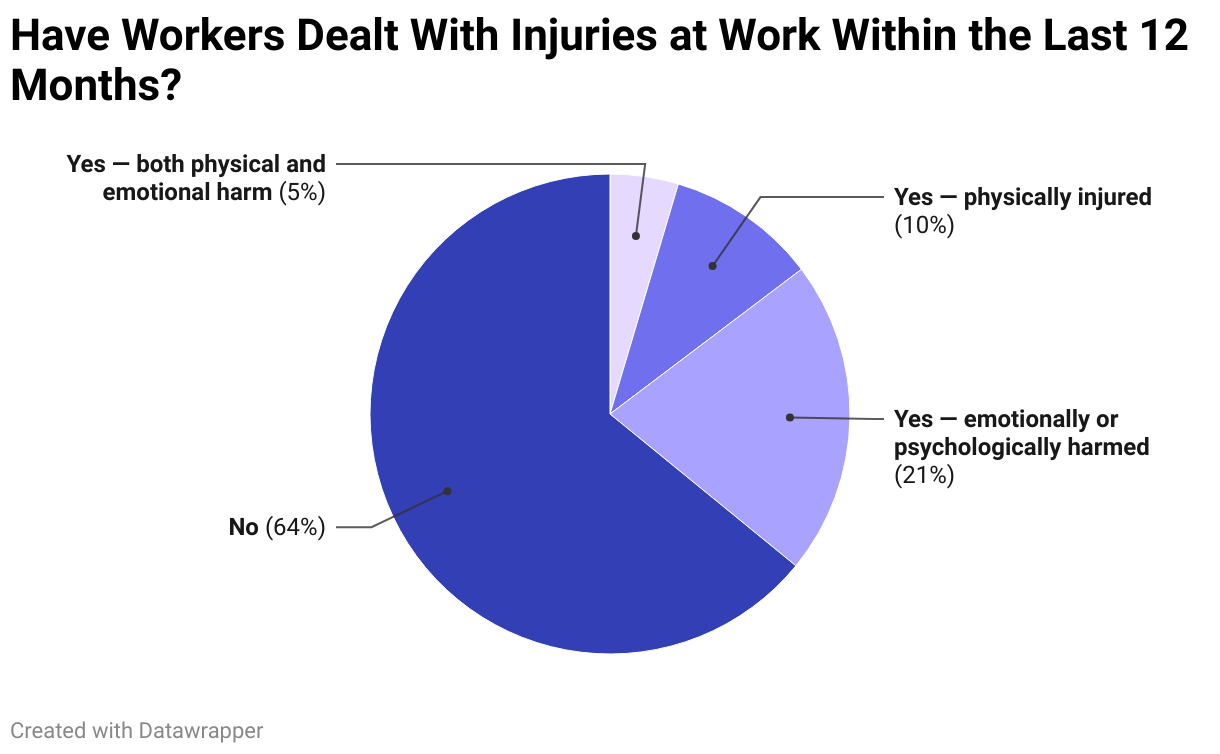Historically, “workplace safety” was largely associated with physical precautions — such as wearing protective gear and preventing slips and falls. However, evolving workforce demographics, shifting regulatory landscapes, and rapid technological advancements are redefining what safety means in the modern workplace. To gain deeper insight into these transformations, we conducted a survey of 1,000 American workers, exploring their perceptions and experiences related to workplace safety.
Key Findings
- 46% of Americans fear a coworker could turn violent on the job.
- 43% of Americans have taken time off due to burnout or mental health stress, and 1 in 4 have even quit a job over these safety concerns.
- 53% of Americans have seen a hostile verbal conflict at work, and more than 1 in 4 were involved themselves.
- Nearly 1 in 4 Americans accept dangerous responsibilities at work due to fear of being fired, prioritizing income over their own safety.
- 38% of Americans would feel less safe with guns permitted at work — but 48% of Gen Z say armed coworkers would make them feel safer.
- More than 1 in 3 Americans say recent ICE activity has made their workplace feel less safe.
- Safety concerns cause nearly 1 in 3 Americans to lose focus at work multiple times a week — and 1 in 10 are so burned out they want to quit every single day.
What Workers Fear Most in 2025

When it comes to safety concerns, Americans as a whole are most worried about health outbreaks, such as the flu and COVID-19. Interestingly, though, Gen Z breaks away from this mold: their top fears are physical injury and mental burnout. Women, in particular, rank burnout as a bigger threat than men do.
That isn’t the only thing Americans are afraid of in the modern workplace, however. When asked if people have feared that their co-worker might commit an act of violence at work, 46% of U.S. workers said yes, with 1 in 5 being worried about this as recently as within the last year.
Safety Isn’t Just Physical

Workplace safety isn’t just about ladders and fire exits anymore — it’s about protecting mental health, too. Gen Z leads the pack in reporting emotional harm or dual injury (41%), while baby boomers are the least likely to say the same at work (17%).

The biggest stressors that pave the way for people to quit? High workload, unrealistic expectations, and feeling emotionally drained or burned out. At the bottom of the list: navigating cultural, political, and ideological differences.

The toll of these stressors is serious — Gen Z is the most likely to consider quitting because of burnout at least a few times a month (a whopping 63% vs. 47% for Americans overall), if not weekly or even daily. That’s more than a bad mood; it’s a retention crisis waiting to happen.
For some, safety concerns actually inspire action. 24% of U.S. workers have quit a job due to safety concerns at work. That figure jumps up to a whopping 38% for Gen Z, with 11% having quit in the last 12 months. This makes safety not just a compliance issue, but a retention one.
Gen Z Is Struggling to Focus, and Safety May Be to Blame

Gen Z is so worried about their safety at work that it’s distracting them throughout the week. 45% of Gen Z report that they are getting distracted and losing focus due to safety concerns at least a few times a week, and it’s hurting their job performance.
Nearly Half of U.S. Workers Are Calling Out Due to Job Stress and Burnout
When asked about calling out or taking a sick day, 17% of Americans said they had done so out of fear of physical harm or feeling unsafe at work, and 43% said they had called out due to stress, burnout, or mental health exhaustion. That number spikes for Gen Z, with 58% saying they’ve called out of work due to stress or burnout.
“I Couldn’t Afford to Say No”: Pressure and Risk-Taking at Work
Sometimes, safety takes a back seat to financial survival or job security.

Gen Z is significantly more likely than other generations to take on risky tasks because they fear being replaced by AI (21%) compared to just 5% of baby boomers.
For lower-income workers, the stakes are even higher — 27% of Americans making under $50,000 have accepted dangerous or high-stress responsibilities simply because they couldn’t afford to lose their jobs, almost triple the number of Americans making more than $150,000 (11%) who have done so. When economic pressure collides with workplace culture, risk often wins.
Voicing Concerns and Facing the Consequences
Speaking up about safety isn’t easy for everyone. About 1 in 5 workers aren’t comfortable voicing safety concerns in the workplace due to fear of retaliation or being ignored. And when concerns aren’t taken seriously, trust takes a hit.

It’s not just about hypothetical scenarios, either — 53% of Americans have been involved in or witnessed a hostile verbal altercation at work in the past year. If follow-through isn’t there, safety talk starts sounding like just that — talk.
Mixed Feelings About AI in the Workplace
AI at work: love it or leave it? Right now, Americans are split 50/50 on whether they want their employer to integrate it more. There’s excitement, but also a shadow of worry — about jobs, ethics, and control — creating a tech trust tug-of-war.
20% of workers strongly support more AI and smart tech integration in their workplace for safety, while 30% of workers want to see an increase in AI integration from their employer to improve safety, but only in specific situations like emergencies or alerts.
DEI Downturns and Political Tensions
While the majority of Americans haven’t noticed any real change, younger workers (13% of millennials and 14% of Gen Z) have noticed a decline in diversity, equity, and inclusion (DEI) efforts — and feel less secure as a result.
The recent increase in immigration enforcement and ICE activities in the workplace adds another layer of anxiety: 37% of Americans say such actions in workplaces have affected their sense of safety.
Despite the fear shaping this landscape, political expression is also on the rise — 48% of Americans say they’ve seen more of it at work in the past year. 18% feel less safe at work as a direct result.
The Trust Gap: Would Coworkers Have Your Back in a Crisis?
15% of Americans say they’re not confident their coworkers or leadership would keep them safe during an emergency. That 15% gap in confidence isn’t just a trust issue — it’s a warning sign for employers to reexamine training, communication, and leadership readiness.
Would Firearms in the Workplace Make Workers Feel Safer? Gen Z Is More Open to It
While 1 in 3 U.S. workers say allowing workers to carry firearms at work would make them feel safer, 38% say they’d feel less safe because of it. Gen Z is the most likely to feel safer if colleagues were armed — 48% compared to just 15% of baby boomers. The difference highlights a generational divide in how “protection” is defined.
What Employers Need To Hear
While the majority of workers (84%) know that their company has an emergency or evacuation plan, only 55% say they understand it clearly. That’s a problem — and a chance for improvement.
Employers should think beyond the rulebook and foster a culture of empathy, transparency, and psychological and physical safety. Modern devices like two-way radios can boost communication and help bridge the gap between policy and real-world preparedness, especially when unsafe situations arise.
Workplace safety in 2025 isn’t just about hard hats and hazard signs — it’s about trust, mental well-being, and adapting to a rapidly changing world. Employers who listen, communicate clearly, and invest in both people and policies won’t just keep workers safer — they’ll keep them engaged, focused, and far more likely to stick around.
Methodology
The findings presented in this report are based on a nationwide survey conducted among 1,000 U.S. citizens age 18 and older who work or have worked in person in the past 12 months. Respondents were asked a series of questions regarding their experiences and perceptions of workplace safety.
The data pool was designed to reflect a comprehensive look at workplace safety in the U.S. The results have been aggregated and analyzed to identify broad trends related to workplace safety and generational perceptions of it.
Fair Use Policy
We welcome the sharing of insights from this study for noncommercial purposes, including academic research, blog content, media coverage, and educational use. If you choose to reference or cite the data presented in this report, we ask that you do so with proper attribution and include a clear link back to this article as the original source. Linking not only supports transparency and credibility but also allows readers to explore the findings in full context. For media inquiries or commercial use, please contact us directly for permission.

